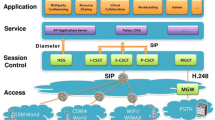Abstract
The modeling of Application Triggering Architecture (ATA) in the IP Multimedia Subsystem (IMS) is presented. The session setup delay and system throughput are employed as the measurement to investigate the performance of ATA and the Serving Call Session Control Function (S-CSCF). With theoretical analysis and simulation results, we find that, the number of the ASs (Application Servers), the use of the subsequent Filter Criteria (sFC) and the arrival rate have heavy impact on the session setup delay and the S-CSCF is the major bottleneck in IMS network. The results are useful in constructing IMS network. At last, we propose several possible solutions to reduce the session setup delay and decrease the load of the S-CSCF.
Similar content being viewed by others
References
3GPP TS 23.002. Network architecture; release 6. 2005.
3GPP TS 23.218. IP Multimedia (IM) session handling; IM call model; Stage 2. 2005.
3GPP TS 23.228. IP multimedia subsystem; Stage 2. 2005.
J. Rosenberg, H. Schulzrinne, et al. RFC 3261. SIP: Session Initiation Protocol. 2002.
3GPP TS 24.229. IP multimedia call control based on Session Initiation Protocol (SIP) and Session Description Protocol (SDP); Stage 3. 2005.
Hanane Fathi, Shyam S. Chakraborty, et al. Optimization of SIP session setup delay for VoIP in 3G wireless networks. IEEE Transactions on Mobile Computing, 5(2006)9, 1121–1132.
G. Camarillo, R. Kantola, and H. Schulzrinne. Evaluation of transport protocols for the session initiation protocol. IEEE Network, 17(2003)5, 40–46.
G. Foster, M. I. Pous, D. Pesch, et al. Performance estimation of efficient UMTS packet voice call control. Proc. IEEE Vehicular Technology Conference, Vancouver, Canada, Sept. 2002, Vol. 3, 1447–1451.
V. K. Gurbani, L. Jagadeesan, and V. B. Mendiratta. Characterizing Session Initiation Protocol (SIP) network performance and reliability. International Service Availability Symposium, Berlin, Germany, April 25–26, 2005, 196–211.
B. Zhu. Analysis of SIP in UMTS IP multimedia subsystem. [Master dissertation], Computer Engineering, North Carolina State University, 2003.
Nisha Rajagopal and Michael Devetsikiotis. Modeling and optimization for the design of IMS networks. 39th Annual Simulation Symposium (ANSS’06), Huntsville, AL, US, April 02–06, 2006, 34–41.
J. Rosenberg. RFC 3311. The Session Initiation Protocol (SIP) UPDATE Method. 2002.
I. Curcio and M. Lundan. SIP call setup delay in 3G Networks. Proceedings of the Seventh International Symposium on Computers and Communications (ISCC’02), Taormina-Giardini Naxos, Italy, July 1–4, 2002, 835–842.
T. Eyers and H. Schulzrinne. Predicting internet telephony call setup delay. Proc. IP Telephony Workshop, Berlin, Germany, April 12–13, 2000, 107–126.
Author information
Authors and Affiliations
Corresponding author
Additional information
Supported by the National Science Fund for Distinguished Young Scholars (No.60525110), the National 973 Program (No.2007CB307100, 2007CB307103), the Program for New Century Excellent Talents in University (No. NCET-04-0111), the Development Fund Project for Electronic and Information Industry (Mobile Service and Application System Based on 3G) and the National Specific Project for Hi-Tech Industrialization and Information Equipments (Mobile Intelligent Network Supporting Value-added Data Services).
Communication author: Xun Zhaoyong, born in 1980, male, Ph.D. candidate.
About this article
Cite this article
Xun, Z., Liao, J., Wang, C. et al. On performance of application triggering architecture in IMS network. J. Electron.(China) 26, 128–137 (2009). https://doi.org/10.1007/s11767-007-0167-0
Received:
Revised:
Published:
Issue Date:
DOI: https://doi.org/10.1007/s11767-007-0167-0
Key words
- Signaling performance
- Session setup delay
- Application triggering architecture
- Session initiation protocol
- IP Multimedia Subsystem (IMS)




